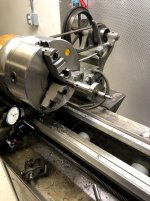ohmanitsdan
Plastic
- Joined
- Mar 5, 2021
Howdy! New here, but planning to dig in and learn a bunch from all of you.
I recently bought a 1971 South Bend 10K model A lathe. It's been apart and back together a few times as I've cleaned it up, re-lubed it, and replaced the lead screw nuts. I shimmed the crossfeed lead screw bushing ~0.036" to get the zero dial tick mark to be anywhere near vertical - not sure if there's a better trick for that, but the biggest problem: I put the handle back on, and the little retaining nut that holds the handle on stripped.
The threads (er, single thread, I guess? hah) on the lead screw appear all kinds of buggered up. The nut also doesn't thread onto any of my standard thread identifiers, nor does it thread onto the lead screw anymore at this point. Per this thread, the threads are likely #12-24 (or 7/32-24, yeeesh), but that doesn't really help me fix the lead screw.
I read through this thread on repairing the handle end threads of the lead screw, but unfortunately, this is the only machine I have so far in my shop. I guess I could limp through cutting some threads into an insert, drill out the end of the lead screw, and press / Loctite in the insert, but it feels a little risky for the very first machining operations on an older machine I've never used.
Does anyone have any other tricks or advice for fixing this?


Thanks in advance!
I recently bought a 1971 South Bend 10K model A lathe. It's been apart and back together a few times as I've cleaned it up, re-lubed it, and replaced the lead screw nuts. I shimmed the crossfeed lead screw bushing ~0.036" to get the zero dial tick mark to be anywhere near vertical - not sure if there's a better trick for that, but the biggest problem: I put the handle back on, and the little retaining nut that holds the handle on stripped.
The threads (er, single thread, I guess? hah) on the lead screw appear all kinds of buggered up. The nut also doesn't thread onto any of my standard thread identifiers, nor does it thread onto the lead screw anymore at this point. Per this thread, the threads are likely #12-24 (or 7/32-24, yeeesh), but that doesn't really help me fix the lead screw.
I read through this thread on repairing the handle end threads of the lead screw, but unfortunately, this is the only machine I have so far in my shop. I guess I could limp through cutting some threads into an insert, drill out the end of the lead screw, and press / Loctite in the insert, but it feels a little risky for the very first machining operations on an older machine I've never used.
Does anyone have any other tricks or advice for fixing this?


Thanks in advance!






